Despite being one of the world’s oldest cities, Athens is a modern and sophisticated 21st century capital. Thankfully for visitors, the city made several improvements in time for the 2004 Summer Olympic Games. These include a new metro system, street tram, and international airport, as well as vast upgrades in road and highway systems. Downtown Athens has more pedestrian-friendly zones than ever before; most major attractions are now easily accessed by one continuous promenade. Shopping, restaurants, sightseeing, and nightlife are now all accessible by foot.

Amidst the Greek economic crisis, Athens is still growing steadily. New hotels, restaurants, boutiques, and high rises are constantly sprouting up. It is not uncommon to find a trendy coffee shop at the end of a gritty alley, or a seemingly grungy taverna with top-notch seafood. Athens is a city of opposites and it’s this type of juxtaposition that makes it so seductive to curious travelers. Any good relationship means you must learn to accept the other person fully, even the flaws. The same goes for Athens. You must learn to embrace all her quirks; the strikes that could leave you stranded, epic beach parties, smoggy days, ancient classics, coffee-addicted culture, and incessant traffic. All of these things make Athens distinctive and unforgettable.

Few places deliver history quite like Athens can. Traces of its 7,000-year evolution from small democratic city-state to modern metropolis are evident throughout its archaeological sites. Athens has been coveted by many world powers throughout time, including the Persians, Romans, and Ottomans. As is the case with most conquered lands, Athens was leveled and rebuilt several times throughout history.
What we see today is a collection of relics left behind by various cultures. It would be impossible to uncover all the ruins of ancient Athens, and almost anywhere you begin to dig there would be remnants of the ancient city. What has been unearthed, however, is nothing short of amazing.

Tip: before you begin exploring ancient Athens, we strongly suggest you purchase a combined ticket for multiple archaeological sites. The pass costs €12 and is good for four days. Sites covered: Acropolis and Parthenon, Ancient Agora, Roman Agora, Hadrian’s Library, Dionysus Theater, New Acropolis Museum, and Kerameikos. Combined passes can be purchased at the ticket office in any of these sites. Here are the top things to see and do in Athens!

No tour to the city is complete with a visit to Acropolis Hill, which is known around the world simply as the Acropolis. Commissioned by the Athenian statesman Pericles in the fifth century B.C., the Acropolis quickly became the tangible symbol of the city’s grandeur. Pericles wanted to make Athens the intellectual center of the ancient world, and as with all great visions came large-scale building projects. The newly designed citadel, which dominated over the center of the city, was to have several components designed by the most talented builders of the day. The Athenian architect Mnesicles was responsible for the grand Propylaea, the official entrance to the Parthenon. The Erechtheion and the Temple of Athena Nike were also added.
Book a Acropolis Afternoon Guided Tour here!
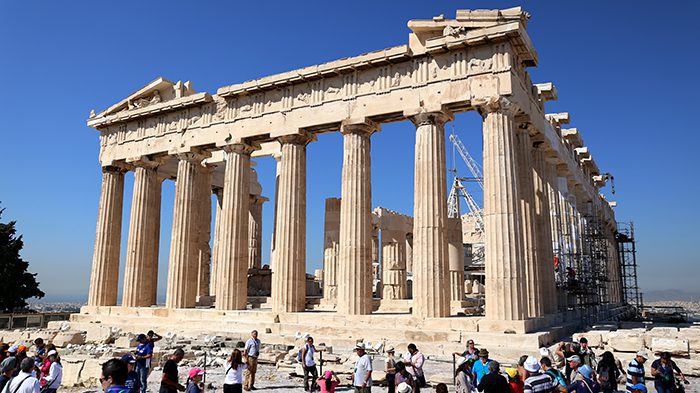
But only one of the buildings continues to be the emblem of democracy, and that is the Parthenon. The Parthenon was an impressive structure for its time – a temple dedicated to Athena made entirely of Pentelic marble and adorned with intricate statues, friezes, and inscriptions about the Greek gods and Athenian victories over the Persians. Architects Iktinos and Kallikrates are credited as the masterminds behind its simple, yet elegant design. The columns of the Parthenon look straight, but are actually thicker at the base to give the illusion of symmetry. This type of optical illusion where objects converge at a single point is called linear perspective. This mathematically based system was developed by the ancient Greeks and has since been applied in many forms of art to create the illusion of depth. A notable work using these principles is the 15th century painting by Leonardo da Vinci, The Last Supper.

Inside the Parthenon stood the massive Athena Parthenos statue. Created by the great sculptor Phidias, she was the cult image of the city. The statue has not survived, but ancient historians describe her as being made of solid gold and ivory and having gilded serpents around her waist and a carved ivory image of Medusa on her breastplate. Despite its current condition, the Parthenon continues to be the most significant building of Classical Greece and one of the world’s most important cultural monuments. Its completion ushered in a new dawn for the city known as the Golden Age of Athens.

Around the base of the Acropolis are several ancient sites, all of which are located within the Archaeological Park. Those closest to the Acropolis are the Ancient Agora, Herodus Atticus Theater, and Dionysus Ancient Theater. The Agora was where democratic principles were put into action – where any citizen of the Athenian state could speak freely about issues of the day. This is where public votes were cast and where great minds congregated. It may not look like much today, but it is where the ideals of western civilization were shaped.

The Dionysus Theater dominates the southern slope of the Acropolis. What we see today is actually a complete remodel made by the Romans to accommodate 17,000 spectators for gladiatorial battles. In ancient Athens, this was where several ancient dramas were first presented, including the tragedies Antigone and Medea.

Walking north from the Acropolis towards Monastiraki you will encounter the Roman Agora. This was a marketplace built in the first century B.C. with funds provided by Emperor Julius Caesar and later by his successor, Emperor Augustus. It replaced the old Greek Agora at the foot of the Acropolis as the city’s main market and commercial zone. The Roman Agora had a large courtyard, several shops, and was accessed by the large Gate of Athena Archegetis.

Near the gate still stands the Tower of the Winds; an octagonal building that got its name from the eight winds carved on each side (North, South, East, West, Northwest, etc.). It had a weathervane at the top to indicate wind direction and eight sundials. Inside was a mechanism powered by water that indicated the time. Known as water clocks, clepsydras were the most accurate time-telling devices of the ancient world before pendulum clocks were invented.

Near the Agora are the ruins of Hadrian’s Library, a prominent building commissioned by Roman Emperor Hadrian in 131 A.D. as part of a plan to revitalize Athens. At the time it was the largest library in the city and housed volumes of historical, academic, philosophical, and religious texts. The original structure had an open-air courtyard with a garden and pool surrounded by several reading rooms and lecture halls. It was destroyed in 267 A.D. Its surviving fragments were later incorporated into the city wall.

East of the Acropolis Metro Station, on the southern edge of the Plaka neighborhood, stand two more important historical sites. The first, Hadrian’s Arch, is a commemorative archway honoring Emperor Hadrian around the same time that Hadrian’s Library was built (131 – 132 A.D.) The gate was built to honor (you guessed it) Hadrian for founding “new Athens” east of the old city. This new district took the name Hadrianoupolis in his honor. Hadrian’s Arch, which is still in remarkable condition, leads the way to another of Emperor Hadrian’s contributions.

The Temple of Olympian Zeus is the largest surviving ancient Athenian temple. It was a building project that lasted over 600 years, beginning in 520 B.C. until its completion in 131 A.D. At one point it contained a colossal gold and ivory statue of Zeus and another of Emperor Hadrian himself. The ruins of the Temple of Olympian Zeus are located just beyond Hadrian’s Arch, east of the Acropolis Metro Station. The site is open daily. General admission is €2.
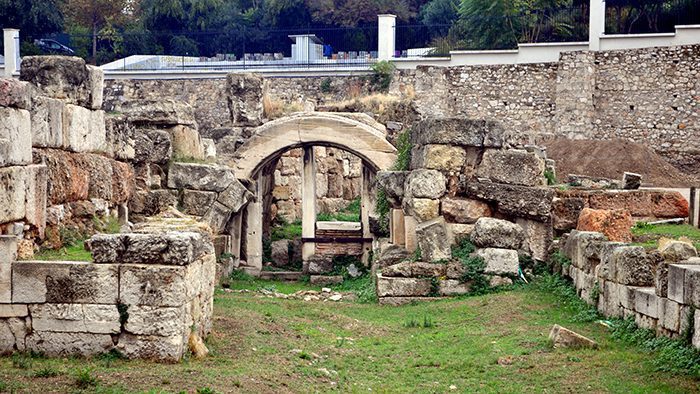
Northwest of the Acropolis, in the Psiri neighborhood, is Kerameikos (148 Ermou Street), the most important cemetery in ancient Athens. Here is where war heroes, prominent city officials, and notable Athenians were laid to rest. The Kerameikos cemetery was located just outside the city’s main gate and used for religious processions and public ceremonies. Perhaps the best way to put the site into perspective is to pair your visit with a stop at the small onsite museum. Here are some of the artifacts recovered from the cemetery including clay figurines, burial stones, and grave offerings. Kerameikos is not known to be a popular tourist site, but it is a treat for history buffs. If you follow Ermou Street from the Monastiraki Metro Station, it is easy to find. You can also get off at the Kerameikos Station and make your way via Voutadon Street. Kerameikos is open daily 8 a.m. to 7:30 p.m. during summer and daily 8:30 a.m. to 3 p.m. during winter. General admission is €2.

Syntagma Square is the main square and transportation hub of Athens. Home of the stately Parliament building, the square is almost always crowded with tourists and locals passing through. Syntagma Square is flanked by the upmarket Kolonaki district and the historical neighborhood of Plaka. Here several Greek soldiers, known as Evzones, guard the Tomb of the Unknown Soldier adorned in full traditional military regalia. These young men are elite members of the Greek Army whose special purpose is to guard the Tomb and Parliament building.
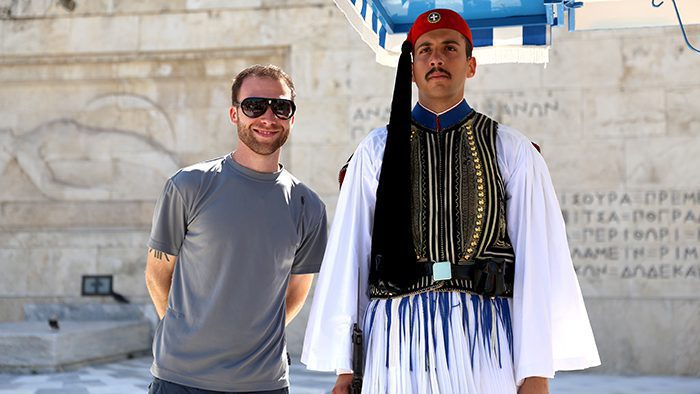
Aside from having your picture taken next to one of the very tall Evzones (most are 6’ 2” or taller) the main attraction here is watching the changing of the guard. The synchronized ceremony takes place every hour on the hour, but Sunday at 11 a.m. are when the guards are in full costume and the ceremony is more intricate.

Syntagma Square marks the beginning of Ermou Street and where the illustrious Hotel Grande Bretagne is located. Syntagma Square has its own Metro station steps away from the Tomb of the Unknown Soldier.
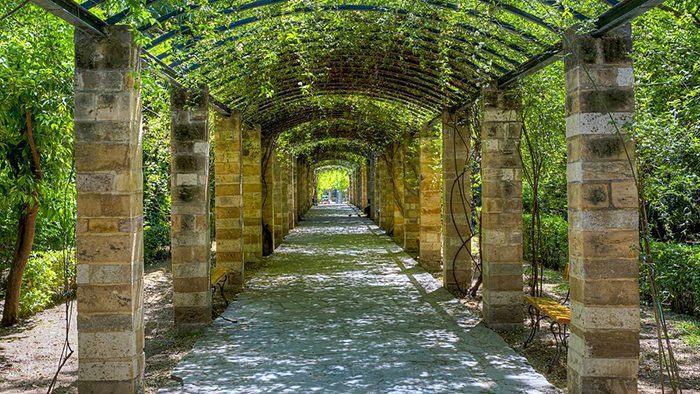
If you are the type of traveler that appreciates a nature walk, take a stroll through the National Gardens. Located just south of the Parliament building, the gardens cover an area of 40 acres. They offer Athenians much-appreciated respite from the hustle and bustle of the city center. While walking down the shaded walkways you will likely encounter peacocks and free-roaming tortoises. The Zappeion Exhibition Hall is located inside the gardens. It also has a designated garden area with marble statues and beautiful landscaping. Both the National Gardens and Zappeion Park are free to enter.
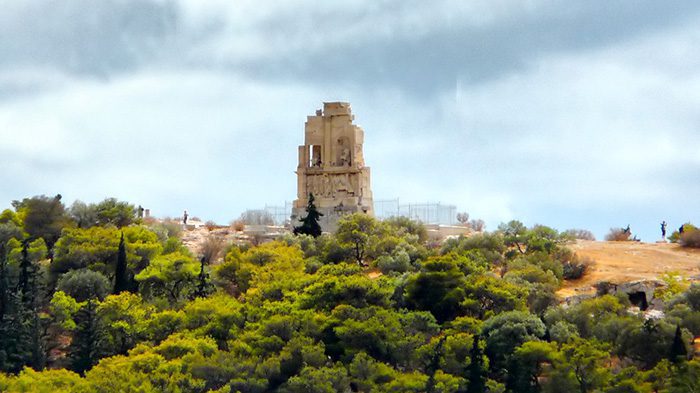
Philopappos Hill, which is actually a cluster of three hills near the Acropolis to the west, was historically known as Mouseion, or Hill of the Muses. From here there are panoramic views of the Acropolis from designated viewing areas. The hill was named after the Roman Senator and prominent Athenian, Gaius Julius Antiochus Epiphanes Philopappos, who died in 116 A.D. Senator Philopappos was a generous benefactor of the city and personal friend of the Emperor, thus a memorial was erected in his honor. His monument, which has a Latin inscription, still stands on the hill.

Tip: if you want to know what the ancient ruins of Athens once looked like, we suggest the website, Ancient Athens 3D. The representations and models show what the buildings, temples, and main areas looked like throughout different historic periods.
Book a Half-Day Sightseeing Tour here!
Greeks are known for their strong cultural identity, and nowhere else is their history more proudly displayed than in the museums of Athens. There is a museum for almost every facet of Greek culture you can think of; folk art, music, jewelry, modern art, theater, and more! You name it, there’s probably a museum that has it.
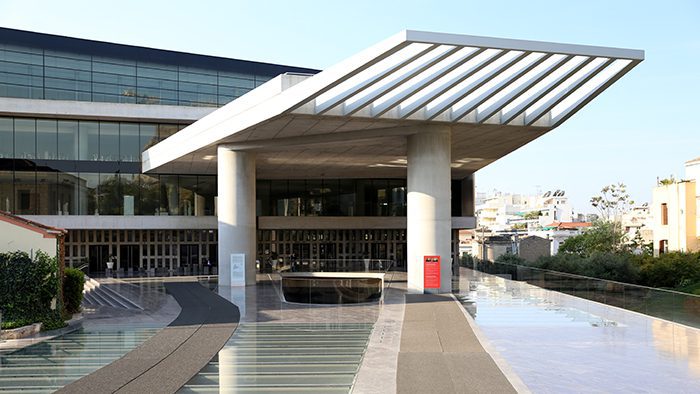
Since opening in 2009, the New Acropolis Museum (15 Dionysou Areopagitou Street) has been considered one of Europe’s finest cultural endeavors. It is the pride and joy of Athens as well as the perfect compliment to a tour of the Acropolis. Conceptualizing and building the museum was a project many years in the making. The result a modern, airy space that beautifully showcases thousands of national treasures. The exhibits take visitors on a journey through the history of Athens starting with its humble start as a small democracy, through its growth into a major port city and into its status as bona fide super power.

Sculptures, pottery, tools, coins, carvings, and religious offerings are just some of the items that give insight into the personal, political, and religious lives of a people whose ideals we still apply today. Stepping into their world is fascinating, perplexing, and thrilling all at the same time. The third floor of the museum is dedicated to the Parthenon. Much of its original friezes and sculptures are housed in the British Museum of London, but curators have installed video displays and cast copies to help guests visualize the completed version. Greece hopes to one day acquire and reunite all the stolen Parthenon friezes here, which is a sensitive topic of ongoing debate. The New Acropolis Museum features a pleasant café, gift shop, as well as stunning views of Acropolis Hill. Each day there are “archaeologist hosts” available to answer any questions free of charge. You can distinguish them by their red and white badges. The museum is open Tuesday through Sunday (Mondays closed). General admission is €5.
Buy your New Acropolis Museum Tickets here!

Several of the city’s best museums are situated along Vasilissis Sofias Avenue. Known as “Museum and Embassy Row,” it is where many prominent embassies and thematic museums are located. A few blocks west of the Evangelismos Metro Station, behind the New Zealand Embassy, is the Museum of Cycladic Art (4 Neophytou Douka Street). Four floors of exhibition space hold ancient finds from the Cycladic Islands and Cyprus, as well as ancient Greek and Byzantine art. This is perhaps the best place in Greece to learn about the first societies of the Aegean.

Highlights of the museum include dozens of clay and stone-carved figurines dating back to the Cycladic Period (3,200 – 2,000 B.C.). These simple, crude human forms provide clues into the religious and funerary rituals of these ancient people. Another exhibit showcases ancient technology with interactive displays demonstrating how everyday objects, like weapons and glass vessels, were made. The museum does a fantastic job of presenting its unique collection in an organized manner with plenty of information. The Museum of Cycladic art is open Monday, Wednesday, Friday and Saturday 10 a.m. to 5 p.m., Thursday 10 a.m. to 8 p.m., and Sunday 11 a.m. to 5 p.m. (Tuesdays closed). General admission is €7.
Other notable museums in Athens include the Benaki Museum (Koumpari Street at Vasilissis Sofias Avenue), National Archaeological Museum (44 Patision Avenue), Herakleidon Arts Museum (16 Herakleidon Street), and the Byzantine Museum (22 Vasilissis Sofias Avenue).

Builders of the Athens metro (subway) system expected to unearth several artifacts when clearing the underground tunnels in time for the 2004 Olympics. Special care was taken to preserve some of these objects, which are now beautifully displayed in mini museums at several stations. The best and largest exhibits, however, can be found at the Acropolis and Syntagma Station Museums. Anyone stop by one of these stations to have a look free of charge at the different objects that were found. Mosaics, pottery, statues, ancient plumbing, and even human remains were some of the items recovered. Allow yourself at least 20 minutes at each station to explore.

Visitors can also take advantage of several other free museums in Athens. These include the Exile Museum (31 Agion Asomaton Street), Greek Musical Instruments Museum (1-3 Diogenous Street), Greek Theatre Museum (50 Akadimias Avenue), and the B & M Theocharakis Foundation for the Fine Arts and Music (9 Vasilissis Sofias Avenue).
Tip: museums in Athens are not required to have the same opening times and admission fees, and some have peculiar schedules. To avoid missing out on the museums you want to see, consult with the museum’s website in advance, or ask your hotel concierge to confirm for you.
Sometimes timing is everything, and depending on when you are in Athens you could score free admission to all of the city’s museums. On these dates entrance is free for all visitors:
Closure dates:
It should come as no surprise that a city as old as Athens would have several districts, each with its own charms and attractions. Tourists often neglect the city’s other neighborhoods and instead just make time for Plaka and Monastiraki. This would be a mistake, as there are several areas to explore! Below is a brief introduction to the main neighborhoods of Athens.

Syntagma (Constitution) Square is the heart of the city. Home to the Parliament building and the Tomb of the Unknown Soldier, it’s a great starting point for any first-time visitor. From here you have access to the elegant Kolonaki district, Ermou Street, and the National Gardens.

In the shadow of the Acropolis lies the historic Plaka neighborhood. This is the most touristic district in Athens due to several archaeological sites, charming side streets, and traditional tavernas. Walking is the best way to get take in all the sights and sounds of Plaka’s labyrinth-like streets. Allow yourself at least a day to explore the Acropolis and meander around Plaka.
Book a Hidden Athens – Plaka and Athens Hills Walking Tour here!

The always-bustling Monastiraki neighborhood lies west of Syntagma Square. Monastiraki Square welcomes visitors with an array of neoclassical buildings, tourist shops, and international restaurants. Standing in the square you will see the Acropolis to the south, a small Byzantine monastery for which the square was named, and a Turkish mosque (now the Ceramics Museum).

After having a proper look around, you can try a traditional souvlaki sandwich at one of the famed tavernas at the end of Metropoleos Street, or enter into the dizzying bazaar of souvenirs around the square. Monastiraki hosts a flea market every Sunday, where everything from honey to household appliances is sold. Monastiraki is also home to the Athens Central Market. See the Markets chapter for more details.

West of Monastiraki is the trendy Psiri neighborhood. By day you could wander the streets to see the restored neoclassical buildings and stop into a traditional leather workshop like the one of famed shoemaker, Stavros Melissinos. Known as “the Poet,” Stavros is a world-renowned sandal maker who has had quite the client list over the years (John Lennon, Jacqueline Kennedy-Onassis, and Sophia Loren just to name a few). Stop into his store (2 Agias Theklas Street) to pick out a beautiful pair of handmade leather sandals (€13 – 30). As the late afternoon rolls in Psiri turns into a bohemian hang out with tables and chairs crowding the sidewalks. Saturday and Sunday evenings are the best time to come and enjoy some Greek meze and ouzo amongst locals.
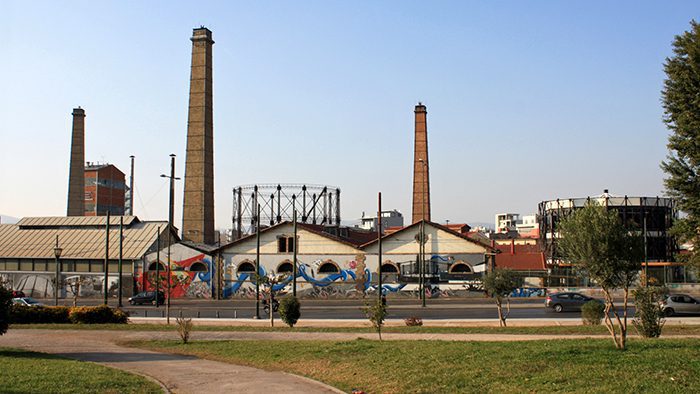
Gazi is the undisputed nightlife hub of Athens. What was once a polluted industrial zone (Gazi means gas) is now a stylish urban district with chic nightclubs, fusion restaurants, modern art galleries, and swanky bars. Gazi’s renaissance began in 1984, and has since prompted the opening of several performing arts venues in the area. The revitalization project has also spread to the nearby Exarchia district. By night, the streets around Gazi Square come alive with dancing and live music.
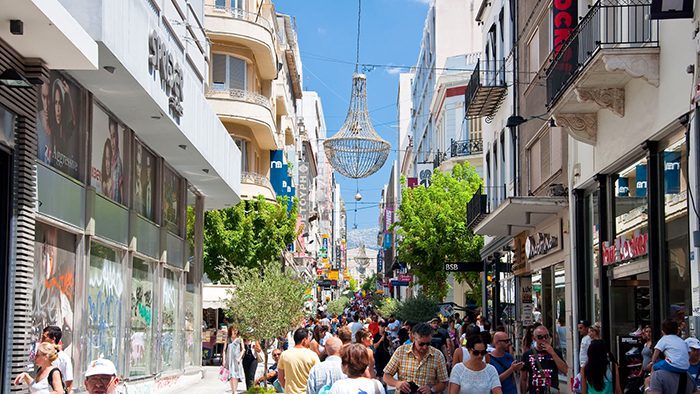
Between Lycabittus hill and Syntagma Square sits the posh Kolonaki district. Bordered by the regal embassies of Vasilissis Sofias Avenue, Kolonaki is known for its high fashion boutiques, upscale eateries, and coffee houses. The area is perfect for an afternoon stroll and a bite to eat around Kolonaki Square, that is if you don’t mind shelling out twice as much money as you would in other areas of Athens. Day or night, you could sit back and people watch over an ice cream or glass of wine at one of its many trendy restaurants. Parking spaces in Kolonaki are limited and expensive, so we recommend taking the metro or walking.
During the summer months the Athenian coast (southern suburbs) comes to life. Athenians and tourists alike come to enjoy the area’s fresh fish tavernas and beautiful beaches, while escaping the heat of downtown. Closest to the city center is Paleo Faliro municipality. Here you could easily spend an afternoon strolling and dining around the Flisvos Marina. Heading south down Leoforos Poseidonos Avenue (coastal road) there are plenty of cafés, restaurants, bars, nightclubs, and boutiques. One coastal town known for its pedestrian-friendly shopping zone and lavish resorts is the ritzy Glyfada. The best beaches for swimming are in the Kavouri-Vouliagmeni area, while Saronida and Anavissos are ideal for windsurfing. The nightlife around the coast is reminiscent of the party scene in the Greek islands. Voula, in particular, has some of the area’s biggest beach clubs. If you don’t have a car, we recommend taking the coastal tram, but note that it will only take you as far south as Voula.
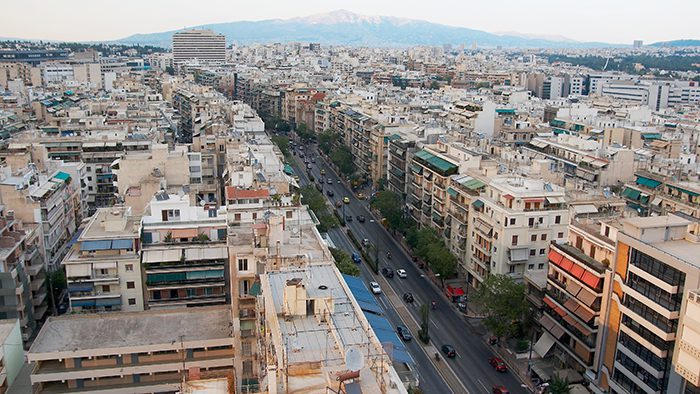
On the opposite side of the city is the Kifissia district in the northern suburbs of Athens. Its elevation allows for picturesque city views and cooler temperatures, which makes it the neighborhood of choice for affluent Athenians. Kifissia is an elegant district strewn with neoclassical mansions, landscaped parks, and trendy restaurants. Often referred to as the “Chelsea of Athens,” Kifissia boasts an upscale shopping scene. Gucci, Prada, and Chanel are just a few of the famous labels you’ll find here. Kifissia is the perfect remedy to the chaotic atmosphere of downtown Athens, even if you are just window shopping.

Piraeus is the largest port of Athens; where thousands of Greeks and tourists catch the ferryboats to the islands, and where thousands more enter each day on cruise ships. To say that Piraeus is busy is an understatement. It’s the commercial hub of the city. Piraeus is comprised of three ports – the central harbor, Pasalimani (Zea), and Mikrolimani (Munichia). While central harbor is reserved for heavy-duty off loading and passenger vessels, Pasalimani and Mikrolimani have several cafés and fish tavernas. Every Sunday Piraeus hosts a bustling flea market that rivals the one in Monastiraki.
Book at Transfer to and from Piraeus and Athens here!
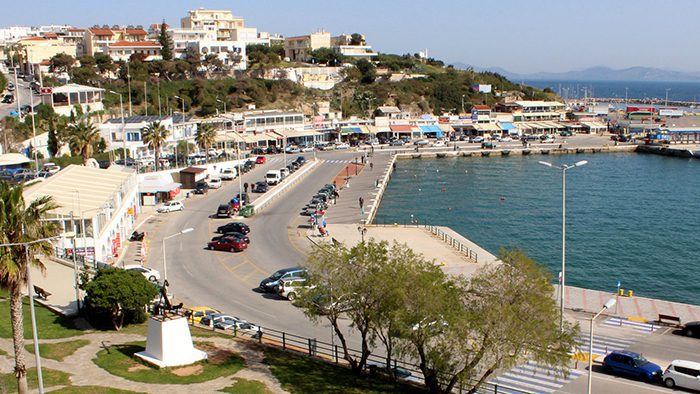
The second largest port in Athens is in the seaside district of Rafina. Though sightseeing here in limited, it is worth mentioning that Rafina is also a major port for passenger ferries headed to the Cycladic Islands of Mykonos, Paros, and Naxos, among others.
Tip: investing in a good map is essential! A city like Athens can seem like a complicated maze of streets and districts, which is why we suggest stopping by one of the city’s official tourist centers to pick up a complimentary map of the city center. If that one does not have the detail you’re looking for, stop at a sidewalk kiosk or bookstore and purchase the Historical Map of Athens by the Greek Archaeological Department (€5).
Part of experiencing any culture is getting acquainted with local foods. Greeks are very particular about their meats and produce – fresh is always better.
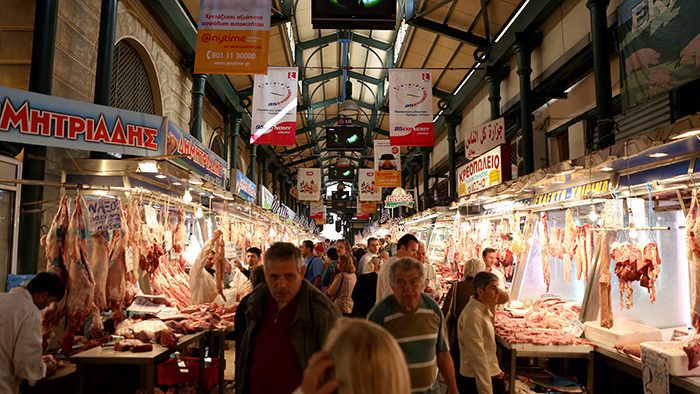
Unfortunately, the city’s modern supermarkets are not half as exciting as the Athens Central Market, or Municipal Market of Athens. This indoor market is a food-lover’s Mecca – freshly butchered meats, Aegean seafood, and exotic spices all under one roof. The Central Market isn’t for the faint-hearted, especially those of you who cringe at the sight of blood. It is a frenzy of activity, but one of the most fascinating ways to see many basic ingredients of Greek cuisine. When you hear the vendors barking out aggressively, don’t be alarmed. This is the traditional way of letting the crowd know the prices of their products. It may seem like a screaming match, but somehow business is getting done.

The Athens Central Market is a short walk from Monastiraki Square, on Athinas and Efripidou Streets. It is open Monday through Saturday 7 a.m. to 3 p.m. Come early on a Saturday, their busiest day, to get the full experience. We recommend wearing closed shoes to avoid getting any splashed with any unwanted fluids on your bare feet. When you are done exploring the meat market, head across the street to the fruit and vegetable market or stop into one of the meat market restaurants for an early lunch. What the restaurants lack in elegance will be forgotten once you try some local delicacies. The fish soup and lamb and potatoes are always crowd pleasers, but if you are feeling adventurous taste the patsa (tripe soup), the Greeks’ secret cure for hangovers.
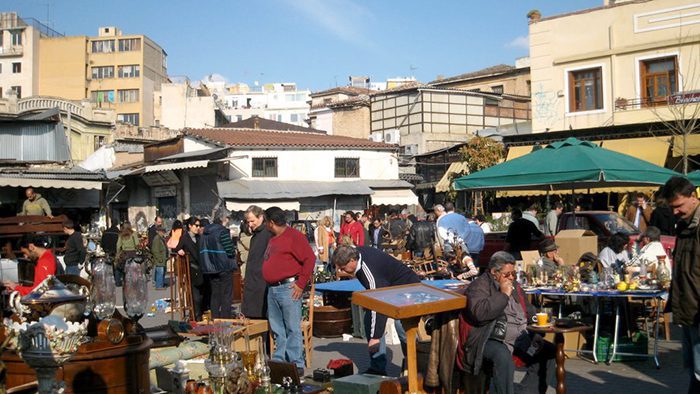
The Monastiraki Flea Market is another one of the city’s best markets. What is most impressive about it is its sheer size! Here you can find almost anything, from old records to Christmas decorations. Most of the inventory is antiques, collectibles, and furniture, but there is the occasional curio that might have you scratching your head about whether or not it should be thrown out. But you know what they say? One man’s junk… If you want something, be prepared to negotiate. Come as early as possible to avoid the mid-day crowds. The market takes place every Sunday around Avissinias Square.
Athens boasts great opportunities to shop, especially for handmade items such as jewelry and leather bags, as well as all-natural beauty products, local herbs, and traditional Greek worry beads (komboloi). Thanks in part to artisanal cooperatives, many of the city’s best boutiques are located alongside each other in the main neighborhoods. Though there are shopping malls in Athens, Greeks generally like to shop at their local boutiques. There is a Hondos Center department store in almost every neighborhood. Here you can find cosmetics, fragrances, toys, leather goods, travel accessories, clothing, shoes, homeware, and other everyday items.

Monastiraki has plentiful souvenir shops and urban clothing. For fine jewelry and traditional Greek products, head to the Pandrossou Street Market.

In terms of selection, the Plaka district is a well rounded shopping area. Plaka is a great place to find original works of art and handcrafted accessories, as well as top European fashions. Plaka also boasts many cafés and restaurants for when you need a break.

Ermou Street, which extends from Syntagma Square to Monastiraki, offers shoppers a little bit of everything in terms of selection and price range. Ermou is pedestrian-friendly and has over 100 stores. Amongst them are popular international brands such as H&M, Mango, and Benetton.
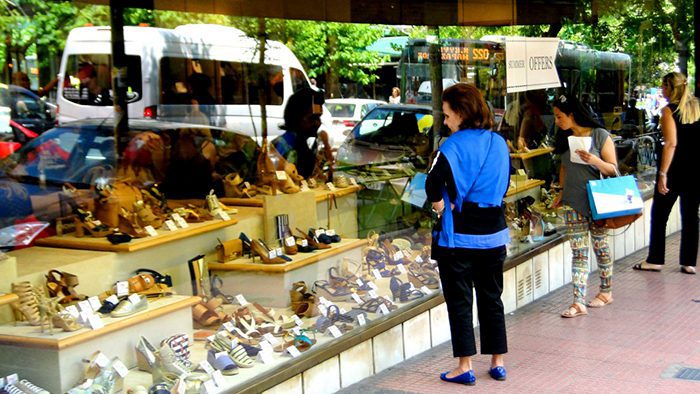
The upscale Kolonaki district is a shopper’s dream come true. You could easily spend an afternoon indulging in luxury labels, or browsing the antiques stores and art galleries. Kolonaki offers some of the best shopping in Greece: Voukourestiou Street (Prada, Tod’s Cartier, Dior), Solonos Street (Lacoste, Follie Follie, Emporio Armani), Skoufa Street (Diesel, Zara, Sisley), Anagnostopoulou Street (Hogan, Pinko, Lapin), and Kolonaki Square (Giorgio Armani, Nike, Massimo Dutti).
Store Hours
The first challenge about shopping in Greece is getting to know the odd working hours. Stores around Athens do not all keep the same hours, but as a general rule:
Pandrossou Street Market: Daily 9 a.m. to 9 p.m

I strongly suggest a stop in Athens before seeing the rest of Greece because here you’ll get a sampling of the best of the country’s culture, people, and food. For years, Athens was the city that Greeks loved to hate – a hot, tourist-infested place that was seen as only for the working class. Thankfully, this is certainly not the case anymore. Since the 2004 Summer Olympic Games, the city has made invaluable strides towards modernizing its infrastructure and streamlining its tourism sector. Visitors can now access most of downtown Athens via one continuous pedestrian path, collect brochures and maps at a central tourism office location, and take advantage of the efficient metro and tram systems.

Athens has the unique advantage of having beaches, an epic party scene, trendy restaurants, and plenty of day trip options. One day just doesn’t cut it anymore (sorry, cruisers). First-timers should dedicate at least four days; two for the city sights and two for day trips. It would be a shame to miss some of the most fascinating ruins of the ancient world, an unrivaled Mediterranean gastronomy, world-renowned hospitality, and quite possibly the most coffee-obsessed destination on the planet. Athens is truly the culmination of all of the splendors of Greece!
Official name: Hellenic Republic, also referred to as “Ellada”
Country population: 11.3 million (2013)
City population: 3.2 million (2013)
Time zone: GMT+2
Language: Greek
Currency: Euro (€)
Currency converter: www.xe.com
Getting around:
Airport transportation: Taxi transfers from the airport to the city center have a flat rate of €35 (5 a.m. to midnight) and $50 (midnight to 5 a.m.). If you want to save money and avoid taking a taxi from the airport into the city, you have three options: Express Bus costs (€5), metro (€8), and suburban rail (€8). If you can manage with your luggage, we recommend taking the metro. A trip from the airport to Syntagma Square station takes about 28 minutes.
Book your Athens Airport Private Taxi here!
Wheelchair access: Sadly, Athens is not well equipped to handle those with mobility impairments. However, the Acropolis, the New Acropolis Museum, and the areas around them have handicap access ramps. However, the main streets of Plaka, Kolonaki, Monastiraki, and Syntagma are possible, as they are relatively flat and offer wide enough sidewalks. The side streets of Plaka and Monastiraki can be tricky neighborhoods to navigate, especially since they have stairs, cobblestone roads, and steep inclines. All metro stations have elevators.
Business hours: As a general rule, banks are open Monday to Thursday from 8 a.m. to 2:30 p.m. and on Fridays from 8 a.m. to 2 p.m. The post office is open Monday to Friday from 8 a.m. to 1 p.m. Hours for shops are influenced by both the season and the area in which they are located
Electricity: 220-240 Volts. Electrical sockets take the European 2-pin round plug. For 110-120 V (U.S. and Canada) appliances, a plug adapter, and in some cases a voltage converter is required.
Airport:
Athens International Airport “Eleftherios Venizelos” (ATH)
+30 210 353 0000
Visitor information:
National Tourism Offices: These are run by the Greek National Tourism Organization (G.N.T.O.) and supervised by the Ministry of Culture and Tourism. They are recognizable by their “Breathtaking Athens” blue logo. These are where you can find them:
Best time to go: To steer clear of the harsh temperatures of summer, try to plan your visit in March, April, or May. October offers pleasant weather, but it may be windy and chilly. The month of August is when most Athenians take their holidays, which means many shops and restaurants will be closed. This, plus the soaring temperatures makes August the month to avoid being in the city.
What are your recommendations for the best places to visit in Athens? We would love to hear from you! Leave us a question or comment below.
Counter
101 Countries • 1432 Cities